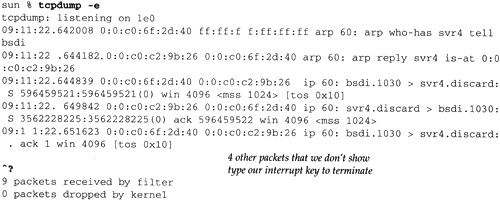A.4 tcpdump Output
A.4 tcpdump Output
The output produced by tcpdump is "raw." We'll modify it for inclusion in the text to make it easier to read.
First, it always outputs the name of the network interface on which it is listening. We'll delete this line.
Next, the timestamp output by tcpdump is of the form 09:11:22.642008 on a system with microsecond resolution, or 09:11:22.64 on a system with only 10-ms clock resolution. (In Appendix B we talk more about computer clock resolution.) In either case the HH:MM:SS format is not what we want. Instead we are interested in both the relative time of each packet from the start of the dump, and the time difference between successive packets. We'll modify the output to show these two differences. The first difference we print with six digits to the right of the decimal point when microsecond resolution is available (two digits when only 10-ms resolution is provided), and the second difference we print with either four digits or two digits to the right of the decimal point (depending on the clock resolution).
In this text most tcpdump output was collected on the host sun, which provides microsecond resolution. Some output was collected on the host bsdi running BSD/386 Version 0.9.4, which only provided 10-ms resolution (e.g., Figure 5.1). Some output was also collected on bsdi when it was running BSD/386 Version 1.0, which provides microsecond resolution.
tcpdump always prints the name of the sending host, then a greater than sign, then the name of the destination host. This makes it hard to follow the flow of packets between two hosts . Although our tcpdump output will still show the direction of data flow like this, we'll often take this output and produce a time line instead. (The first of these in the text is Figure 6.11.) In our time lines one host will be on the left, and the other on the right. This makes it easier to see which side sends and which side receives each packet.
We add line numbers to the tcpdump output, allowing us to reference specific lines in the text. We also add additional space between certain lines, to separate some packet exchanges.
Finally, tcpdump output can exceed the width of the page. We wrap long lines around at convenient points in the line.
As an example, the output produced by tcpdump corresponding to Figure 4.4 is shown in Figure A.3, assuming an 80-column terminal window.
We won't show our typing the interrupt key (which terminates tcpdump ) and we won't show the number of packets received and dropped. (Dropped packets are those that arrived faster than tcpdump could keep up with. Since the examples in the text were often run on an otherwise idle network, this is always 0.)
Figure A.3. tcpdump output for Figure 4.4.

EAN: 2147483647
Pages: 378